City Branding:
Part 3: Observation Towers in the USA
Landmarks Create US City’s Identity & Image
What’s Your
City’s Claim to Fame?
By Jeff Coy, IHSC
December 19, 2011
Orlando is the number one most visited city in the USA with
48 million domestic and international visitors, according to Forbes,
followed
by New York City, Chicago and Anaheim. OK,
I can understand why Orlando is #1. It
has landmarks and visual images that are immediately
recognizable.
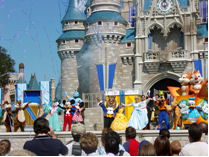 Just say the word Orlando and visual images of Mickey
Mouse, the
Magic Kingdom, Shamu and thrill rides appear in my mind’s eye.
Just say the word Orlando and visual images of Mickey
Mouse, the
Magic Kingdom, Shamu and thrill rides appear in my mind’s eye.
| Top
10 Most Visited US Cities |
| City
|
Number
of Visitors |
| Orlando
FL |
48,000,000
|
| New
York City NY |
47,000,000
|
| Chicago
IL |
45,580,000
|
| Anaheim/Orange
County CA |
42,700,000
|
| Miami
FL |
38,100,000
|
| Las
Vegas NV |
36,351,469
|
| Atlanta
GA |
35,400,000
|
| Houston
TX |
31,060,000
|
| Philadelphia
PA |
30,320,000
|
| San
Diego CA |
29,600,000
|
| Sources:
Forbes, Smith Travel Research & US Travel Association
|
Say New York City and I see images of the Big Apple, the
Statue of Liberty, Times Square and Broadway theaters.
I can even hear Frank singing, “these little
town blues are melting away.” Mention
Chicago, and I see the Sears/Willis
Tower and Oprah and I can hear the blues. And
when you say Anaheim, I envision all the fun things to
see and do at
Disneyland, Sea World and Knott’s Berry Farm. What’s
your city’s claim to fame?
On the world stage, New
York City was the USA’s most-visited city in 2010 with 9.7 million
international arrivals, according to the World Tourism
Organization. The Top 10 Favorites are headed by Paris,
London and NYC --- cities with strong architectural icons, nicknames,
slogans
and songs that are immediately recognizable around the world.
|
Top 10 Most Visited
by International Tourists
|
|
Rank
|
Country
|
2010
|
|
Rank
|
City
|
2010
|
|
1
|
France
|
76.8
million
|
|
1
|
Paris
|
15.1
million
|
|
2
|
United
State
|
59.7
million
|
|
2
|
London
|
14.6
million
|
|
3
|
China
|
55.7
million
|
|
3
|
New
York City
|
9.7
million
|
|
4
|
Spain
|
52.7
million
|
|
4
|
Antalya
|
9.2
million
|
|
5
|
Italy
|
43.6
million
|
|
5
|
Singapore
|
9.2
million
|
|
6
|
United
Kingdom
|
28.1
million
|
|
6
|
Kuala
Lumpur
|
8.9
million
|
|
7
|
Turkey
|
27.0
million
|
|
7
|
Hong
Kong
|
8.4
million
|
|
8
|
Germany
|
26.9
million
|
|
8
|
Dubai
|
8.3
million
|
|
9
|
Malaysia
|
24.6
million
|
|
9
|
Bangkok
|
7.2
million
|
|
10
|
Mexico
|
22.4
million
|
|
10
|
Istanbul
|
6.9
million
|
|
Source:
World Tourism Organization
|
Paris has the Eiffel Tower, Arch of Triumph, Notre Dame,
Moulin Rouge and Palace of Versailles. London
has Big Ben and Tower of London. New
York has many visual symbols that project the city’s personality and
hospitality.
The rest of the world’s favorite cities include the
emerging
destinations of the Middle East and Asia --- evidence of a blossoming
middle
class that is traveling the Asian continent and, hopefully, will soon
discover
America. Consider the millions of global
travelers visiting their favorite cities, such as Antalya, Singapore,
Kuala
Lumpur, Hong Kong, Dubai, Bangkok and Istanbul.
What’s your city’s claim to fame? Is your
city an attractive place to visit?
Global
Travel Market
Currently, “the USA struggles to attract international
guests,” according to HotelNewsNow.com, “due in part to a bloated visa
process
and the lack of a cohesive unified marketing push.”
The total number of global travelers grew from 152 million
in 2000 to 213 million in 2010, yet the US market share dropped from
17% in
2000 to 12.4% in 2010. Brazil, China and
India are the fastest-growing, highest-spending sources of overseas
travel to
the US, but the wait to even apply for a yearly visa can be 100 days or
more.” We are talking about a visa to
visit the US, spend money, create American jobs and then go back home,
not to
stay here. This delay results from
policies adopted following 9/11 but it doesn’t make our country safer;
it just
makes us look like we can’t process visitors effectively.
But according to the US Travel Association, all that is
changing fast.
What is
Brand USA?
The Corporation for Travel Promotion is transforming into Brand
USA Inc, a public-private partnership created to restore our prominence
as a
destination in the world. Brand USA is
okay as a name, but it is not a marketing strategy.
It is not a slogan, it is not a tag line and
as a message it communicates nothing. “To
me, Brand USA gives no reason for people in China to
visit the US,”
say Ed Watkins, editor of Lodging Hospitality.
The USA needs to establish its brand as a destination in the
world. In fact, we have had a strong
brand in the past --- we just got off track a bit.
Our national mission statement is wrapped up
in our monuments, the Statue of Liberty, our Declaration of
Independence, the
US Constitution and our Bill of Rights. That’s
who we are! That’s
Uncle
Sam. And Uncle Sam wants you --- to
visit America.
USA Top
Observation Towers
To compete for world travelers, our country and our cities
need to create an identity and image that can project personality and
hospitality --- inviting the world to visit us. Identity
and image are built from landmarks, monuments,
architectural
icons, nicknames, slogans and songs written and sung about our country
and our
cities. Let’s visit a few:
Top Observation
Towers in the USA
|
Name
|
City
|
Height
feet
|
Year
Open
|
Rest
|
Ride
|
Hotel
|
Cost
to Construct
|
Annual
Attendance
|
Owner
|
|
Stratosphere
Tower
|
Las
Vegas NV
|
1149
|
1996
|
X
|
X
|
X
|
$550,000,000
|
|
Whitehall
Street RE
|
|
Royal
Gorge Bridge
|
Royal
Gorge CO
|
1053
|
1929
|
|
X
|
|
|
|
Royal
Gorge Bridge
|
|
Tower
of the Americas
|
San
Antonio, TX
|
750
|
1968
|
X
|
X
|
|
|
|
|
|
Gateway Arch
|
St. Louis MO
|
630
|
1965
|
|
X
|
|
$13,000,000
|
4,000,000
|
US
National Park Service
|
|
Space Needle
|
Seattle
WA
|
605
|
1962
|
X
|
|
|
$4,500,000
|
1,300,000
|
Space
Needle Corporation
|
|
JFK Space Center
Launch Pad
|
Cape
Canaveral, FL
|
600
|
2009
|
|
|
|
|
|
NASA
|
|
Carew Tower
|
Cincinnati, OH
|
574
|
1929
|
X
|
|
X
|
$33,000,000
|
|
US
National Historic Landmark
|
|
San Jacinto Monument
|
La Porte, TX
|
567
|
1939
|
|
|
|
$1,500,000
|
250,000
|
US
National Historic Landmark
|
|
Reunion Tower
|
Dallas
TX
|
560
|
1978
|
X
|
|
X
|
|
|
|
|
Washington Monument
|
Washington,
DC
|
555
|
1884
|
|
|
|
$1,187,710
|
800,000
|
US
National Park Service
|
|
Las
Vegas Eiffel Tower
|
Las
Vegas NV
|
540
|
1999
|
X
|
X
|
|
$785,000,000
|
|
Caesar's
Entertainment
|
|
Penobscot
Observatory
|
Penobscot
RI
|
446
|
2007
|
|
|
|
|
|
|
|
Gatlinburg Space
Needle
|
Gatlinburg
TN
|
407
|
1970
|
|
|
|
|
|
|
|
Jefferson Davis
Monument
|
Fairview, KY
|
351
|
1924
|
|
|
|
$200,000
|
|
Kentucky
State Park
|
|
Perry's Victory
& Intl Peace Memorial
|
Put-in-Bay, OH
|
351
|
1915
|
|
|
|
|
200,000
|
US
National Park Service
|
|
Total Tower Elitch
Gardens
|
Denver
CO
|
336
|
|
|
|
|
|
|
|
|
Statue
of Liberty
|
New
York
|
305
|
1886
|
|
|
|
|
|
|
|
Sunsphere
Knoxville
|
Knoxville
TN
|
266
|
1982
|
X
|
|
|
|
|
|
|
Liberty
Memorial
|
Kansas
City MO
|
216
|
1926
|
|
|
|
|
|
|
|
Coit
Tower
|
San
Francisco CA
|
210
|
1933
|
|
|
|
|
|
|
|
Source:
Jeff Coy, JLC Hospitality Consulting, 480-488-3382.
www.jeffcoy.com Rest=Restaurant. Ride=Thrill
Ride. Hotel=Hotel Integrated, Attached or
On-Site.
|
Stratosphere is a
tower, casino and hotel that opened in 1996 in Las Vegas NV. At
1,149 feet high, it is the tallest
observation tower in the US. The casino
covers 80,000 sq feet and the hotel has 2,427 rooms in a separate
24-story
building. At the top of the tower, there
are two observation decks, a revolving restaurant known as “Top of the
World”
and four thrill rides: (1) Big Shot, (2) Insanity, (3) X-Scream and (4)
Sky
Jump.
Big
Shot at 1,081 feet is the highest thrill ride in the world. Strap
into the Big Shot and prepare to be
shot 160 feet into the air at 45 mph as you overlook Las Vegas.
In a matter of seconds, the Big Shot thrill
ride catapults 16 riders from the 921-foot high platform up the tower’s
mast to
a height of 1,081 feet and down again.
Before you can catch your breath, you’ll be shot back up again at 4 Gs
of force on the way and feel negative Gs on the way down. Cost to
ride is $13.
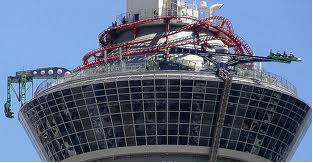 Insanity the Ride is a
mind-blowing experience. It opened in
2005 at 900 feet. It is the second
highest thrill ride in the world. A
massive mechanical arm extends out 64 feet over the edge of the
Stratosphere
Tower at height of over 900 feet. This
ride will spin you in the open air at speeds of up to 3 Gs. You will be propelled to an angle of 70
degrees, which will tilt your body into one position --- straight down! If you’re brave enough to keep your eyes
open, you’ll get a breathtaking view of historic downtown Las Vegas. Cost to ride is $12.
Insanity the Ride is a
mind-blowing experience. It opened in
2005 at 900 feet. It is the second
highest thrill ride in the world. A
massive mechanical arm extends out 64 feet over the edge of the
Stratosphere
Tower at height of over 900 feet. This
ride will spin you in the open air at speeds of up to 3 Gs. You will be propelled to an angle of 70
degrees, which will tilt your body into one position --- straight down! If you’re brave enough to keep your eyes
open, you’ll get a breathtaking view of historic downtown Las Vegas. Cost to ride is $12.
X-Scream
is the
third highest thrill ride in the world. Ever
played on a giant teeter-totter 866 feet above the
ground? X-Scream propels you and several
other riders
headfirst 27 feet over the edge of the Stratosphere 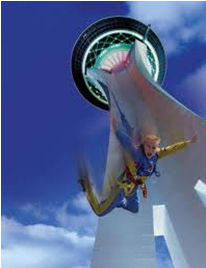 Casino, Hotel &
Tower. You’ll dangled weightlessly above
the strip before being pulled back and then propelled back out over the
edge
again. Cost to ride is $12.
Casino, Hotel &
Tower. You’ll dangled weightlessly above
the strip before being pulled back and then propelled back out over the
edge
again. Cost to ride is $12.
In January 2010,
American Casino & Entertainment Properties announced a fourth
thrill ride
called SkyJump for the top of the tower.
SkyJump is a controlled free fall that sends you jumping off the 108th
floor at a scream-inducing speed. The
bungee jumping-like ride allows riders to plummet 855 feet attached to
a high
speed, descent wire. It opened on April
20, 2010. Cost to ride is $110. For more, go to www.skyjumplasvegas.com.
Stratosphere is
owned by Whitehall Street Real Estate Funds, an affiliate of
Goldman-Sachs who
purchased American Casino & Entertainment Properties in 2008.
 Royal Gorge Bridge &
Park is a tourist attraction near Canon City CO within a 360-acre
theme park. Royal Gorge is a natural
wonder
2,500 years in the making. The bridge
deck hangs 955 feet above the Arkansas River and held the record of the
highest
bridge in the world from 1929 until 2003, when it was surpassed by the
Beipanjiang River Bridge in China. It is
still the highest bridge in
Royal Gorge Bridge &
Park is a tourist attraction near Canon City CO within a 360-acre
theme park. Royal Gorge is a natural
wonder
2,500 years in the making. The bridge
deck hangs 955 feet above the Arkansas River and held the record of the
highest
bridge in the world from 1929 until 2003, when it was surpassed by the
Beipanjiang River Bridge in China. It is
still the highest bridge in 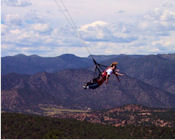 North America. Royal Gorge
Bridge is suspended from towers that are 150
feet high and
runs a length of 1,270 feet. The bridge
was constructed in six months during 1929 at a cost of $350,000, which
would be
$15 million today. From 1982-1983 the
bridge was renovated to the tune of $2.8 million. The
bridge owners hosted the television show That’s Incredible
for a group of British
bungee jumpers from the Oxford Dangerous Sports Club.
In addition, GM filmed a Super Bowl TV
commercial at the bridge. Attractions at
the bridge include an Aerial Tram, a Cliff Walk scenic overhang and the
Royal
Rush Skycoaster, built in 2003 and voted the scariest skycoaster in the
world. Three people are harnessed in per
ride,
starting from a 100-foot tower and traveling up to speeds of 50 mph
across the Arkansas
River 1,200 feet high. Other attractions
include: railroad, carousel, trolley, inclined railway, theater,
petting zoo,
burro rides, trading post, wildlife park, entertainment pavilion, mule
team
rides, water clock, trail rides, dog kennels and gun fights.
North America. Royal Gorge
Bridge is suspended from towers that are 150
feet high and
runs a length of 1,270 feet. The bridge
was constructed in six months during 1929 at a cost of $350,000, which
would be
$15 million today. From 1982-1983 the
bridge was renovated to the tune of $2.8 million. The
bridge owners hosted the television show That’s Incredible
for a group of British
bungee jumpers from the Oxford Dangerous Sports Club.
In addition, GM filmed a Super Bowl TV
commercial at the bridge. Attractions at
the bridge include an Aerial Tram, a Cliff Walk scenic overhang and the
Royal
Rush Skycoaster, built in 2003 and voted the scariest skycoaster in the
world. Three people are harnessed in per
ride,
starting from a 100-foot tower and traveling up to speeds of 50 mph
across the Arkansas
River 1,200 feet high. Other attractions
include: railroad, carousel, trolley, inclined railway, theater,
petting zoo,
burro rides, trading post, wildlife park, entertainment pavilion, mule
team
rides, water clock, trail rides, dog kennels and gun fights.
Tower of the Americas
in downtown San Antonio, Texas is another observation tower with
restaurant and
thrill rides. After 18 months of
construction, the tower opened at 750 feet as the themed structure for
the 1968
World’s Fair. Designed by architect
O’Neill Ford, it was the  tallest observation tower in the USA from 1968-1996,
when the Las Vegas Stratosphere Tower was completed.
Two observation decks are accessible by
elevator for a fee $10.95 for adults. At
800 feet per minute, it takes only 43 seconds for the elevators to
climb to the
top. Three elevators can carry 1,950
passengers
per hour. The outdoor observation deck
can handle 340 people while the indoor observation area accommodates
500
people.
tallest observation tower in the USA from 1968-1996,
when the Las Vegas Stratosphere Tower was completed.
Two observation decks are accessible by
elevator for a fee $10.95 for adults. At
800 feet per minute, it takes only 43 seconds for the elevators to
climb to the
top. Three elevators can carry 1,950
passengers
per hour. The outdoor observation deck
can handle 340 people while the indoor observation area accommodates
500
people.
The top house was constructed on the ground and hoisted,
using cables, up to the top of the poured concrete shaft.
The revolving top house at the top of the
tower is 76 feet tall. It is so well
balanced that it takes just a 1 horsepower motor to rotate the
structure. The top house consists of a
lounge and
revolving 250-seat restaurant which occupied 10,150 sq feet. In 2004, Landry’s Restaurants Inc won a
15-year lease to manage the tower for the City of San Antonio. Landry’s completed an $8 million renovation
of restaurant, lounge and observation deck and added a 4-D “ride”
called Skies
Over Texas that gives the history of Texas in a film format. Landry’s spent another $4 million to add
ground level attractions, café and gift shop.
The tower reopened in 2006 with the new Eyes Over Texas
restaurant,
which converted to Chart House in 2007. The
Skies Over Texas 4-D theater film ride continues to
take visitors on
a high-flying trip across the Lone Start State, zooming in on such
scenes as a
Friday night high school football game and working up close with a
space
shuttle at NASA.
Gateway Arch aka
the St Louis Arch or Gateway to the West completed construction in 1965
as a
monument to the westward expansion of the United States.
At 630 feet high, it is the tallest man-made
monument in the US. Designed by
Finnish-American architect Eero Saarinen and structural engineer
Hannskarl
Bandel in 1947. Construction period was
32 months, costing US$13 million at the time or about US$90 million
today. Opened in 1967.
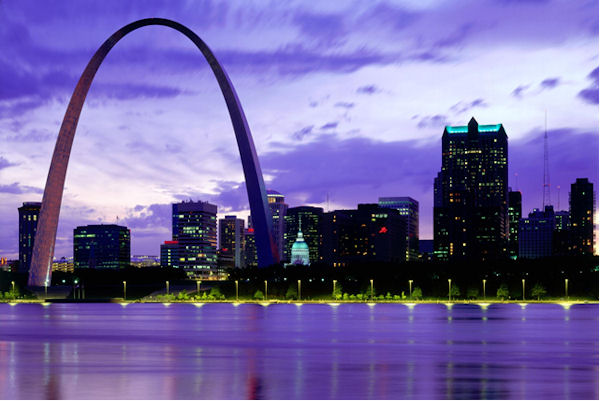
During hard times in 1933, civic leader Luther Ely Smith
noticed the crumbling St Louis riverfront and envisioned that building
a
memorial there would both revive the riverfront and stimulate the
economy. He communicated his idea to the
mayor who raised
it in a meeting with city leaders. They
sanctioned the proposal and the non-profit Jefferson National Expansion
Memorial Association was formed. Smith
was appointed chairman and the mayor vice chairman.
Their goal was to create a permanent memorial
to the men who made possible the western territorial expansion of the
US --- particularly
President Jefferson, his aides Livingston and Monroe, the great
explorers,
Lewis and Clark, and the hunters, trappers, frontiersmen and pioneers
who
contributed to the accomplishment. In
1934, a bill asking for $30 million was introduced in the US Congress,
but it
failed. Joint resolutions establishing a
federal commission to dvelope the memorial also met with opposition. Finally, President Franklin D. Roosevelt
signed a bill into law establishing the US Territorial Expansion
Memorial Commission. Design competition
guidelines were written in
1935 and the $30 million budget was set. The
Public Works Administration and the Works Progress
Administration
each promised $10 million, and it was decided that the National Park
Service
would manage the memorial. Roosevelt’s
executive order approved the memorial, designated the first National
Historic
Site and appropriated the money to acquire the buildings within the
historic
site --- through condemnation rather than purchase --- and demolish
them. Demolition was complete in 1938, and
the
design competition ran from 1945-1948. It
took years to relocate railroads.
Finally, the project broke ground in 1959, and the
foundation of the structure was laid in 1961. Construction
of the arch itself began in 1963 and
completed in
1965. Gateway Arch did not provide 5,000
jobs as expected. As of 1964, workers
numbered fewer than 100. The project
did, however, lead to other riverfront restoration efforts totaling
$150
million.
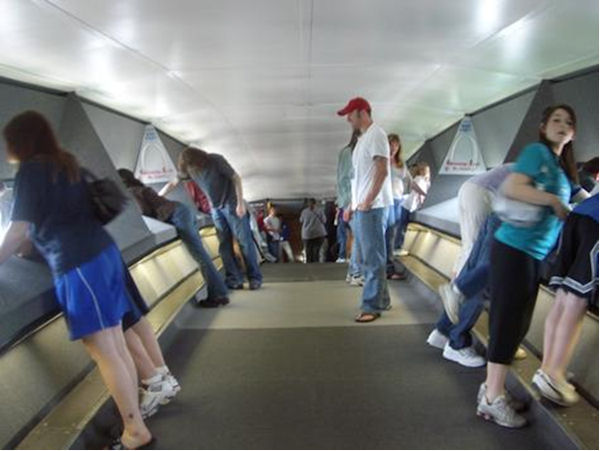
More difficult to build than a 62-story skyscraper, the
Gateway Arch is an inverted weighted catenary shape --- a chain that
supports
its own weight. The legs of the arch are
bigger than the arch at the top. There
are 3 ways to reach the top: two sets of emergency stepping stairs, a
12-passenger elevator to the 373-foot level and a tram in each leg. Near the top of the arch, passengers exit the
tram and climb a slight grade to enter the arched observation area. There are 32 windows (16 per side) each
measuring 7 by 27 inches that provide views of St Louis and across the
Mississippi River. The observation deck
can handle about 160 people --- the capacity of four trams.
The Seattle Space
Needle is a towering symbol for the City of Seattle and a major
landmark
for the Pacific Northwest. Located at
the Seattle Center, it was built for the 1962 World’s Fair. Nearly 20,000 people a day or a total of 2.3
million people used the elevators during the fair.
The Space Needle is 605 feet high. When
it was completed, it was the tallest
structure west of the Mississippi River. In
some photos the Space Needle appears higher than
Seattle’s
skyscrapers --- that’s because it is located in a prominent position
nearly one
mile northwest of downtown.
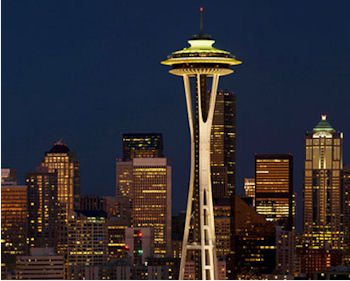 The Space Needle features an
observation deck at 520 feet
and the rotating SkyCity Restaurant at 500 feet. Visitors
reach the top in 43 seconds via
elevators. In 1993, new computerized
elevators were installed. The new
elevators descend at a rate of 10 mph or 15 feet per second. About 1.3 million tourists visit the
observation tower annually at an average ticket price of $16.
The Space Needle features an
observation deck at 520 feet
and the rotating SkyCity Restaurant at 500 feet. Visitors
reach the top in 43 seconds via
elevators. In 1993, new computerized
elevators were installed. The new
elevators descend at a rate of 10 mph or 15 feet per second. About 1.3 million tourists visit the
observation tower annually at an average ticket price of $16.
Hotelier Ed Carlson, president
of Westin International and
chairman of the 1962 Seattle World’s Fair had the idea for erecting a
tower
with a restaurant after a visit to see Stuttgart Tower in Germany. John Graham Jr got involved and made it a
revolving restaurant similar to the tower he designed fo r the Ala
Moana
shopping center in Honolulu.
The proposed Space
Needle had no land on which to be
built. Since the tower was not financed
by the city, land had to be purchased within the fairgrounds. The search for a site was nearly dead when
investors
discovered a 120x120 plot one year prior to the opening of the fair. The land sold for $75,000.
The Space Needle was privately financed by
the Pentagram Corporation which consisted of Bagley Wright, contractor
Howard
S. Wright, architect John Graham, Ned Skinner and Norton Clapp. In 1977, Bagley, Skinner and Clapp sold their
interest to Howard Wright who now controls it under the name of Space
Needle Corporation. With time an issue,
the construction crew
worked around the clock. The Space
Needle was finished in less than one year. Construction
cost was $4.5 million. It is built to
withstand winds of up to 200 mph and
earthquakes up to
9.1 magnitude. The top dome, consisting
of 5 levels of observation deck and restaurant, was perfectly balanced
so it
could rotate using a 1.5 hp motor. In
2000, the SkyCity restaurant, observation deck and base retail store
were
renovated and the Skybeam was installed at a cost of $21 million. In 2007, the Space Needle welcomed its 45th
millionth visitor. Although it isn’t one
of the tallest towers in the world, the Seattle Space Needle is one of
the most
prominent. Over the years, it has
appeared in numerous films such as It
Happened at the World’s Fair (1962), Sleepless
in Seattle (1993) and TV shows Frasier
and Grey’s Anatomy.
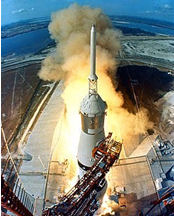 Kennedy Space Center
Launch Complex 39 is a NASA rocket launch site on Merritt Island in
Florida
that consists of two launch pad towers, a Vehicle Assembly Building
crawler-transporter, launch control center and other support buildings
used in
the Apollo, Saturn programs and later Space Shuttle operations. Each pad contains a 2-piece access tower
system. One piece provides access to the
Shuttle via a retractable arm. The
second piece offers “clean” access to the orbiter’s payload bay and
provides
protection from weather and winds up to 60 knots. Although
this is not your typical observation
tower, it is the view you have seen on TV when astronauts are entering
the
cockpit of the space module. LC-39A:
First launch was 1967; last launch was the Space Shuttle Atlantis in
July
2011. With the retirement of the Shuttle
in 2011, the future of the LC-39 towers is undetermined.
NASA is offering the pad and facilities to
private companies to fly missions for the commercial space market.
Kennedy Space Center
Launch Complex 39 is a NASA rocket launch site on Merritt Island in
Florida
that consists of two launch pad towers, a Vehicle Assembly Building
crawler-transporter, launch control center and other support buildings
used in
the Apollo, Saturn programs and later Space Shuttle operations. Each pad contains a 2-piece access tower
system. One piece provides access to the
Shuttle via a retractable arm. The
second piece offers “clean” access to the orbiter’s payload bay and
provides
protection from weather and winds up to 60 knots. Although
this is not your typical observation
tower, it is the view you have seen on TV when astronauts are entering
the
cockpit of the space module. LC-39A:
First launch was 1967; last launch was the Space Shuttle Atlantis in
July
2011. With the retirement of the Shuttle
in 2011, the future of the LC-39 towers is undetermined.
NASA is offering the pad and facilities to
private companies to fly missions for the commercial space market.
Carew
Tower,
completed in
1930, stands 49 stories tall in the
heart of downtown Cincinnati overlooking the Ohio River. It
contains the Hilton Cincinnati Netherland 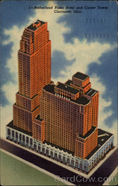 Plaza (formerly the Omni
Netherland Plaza). The
hotel is described as "one of the world's finest examples of French Art
Deco architecture" and was used as the model for the Empire State
Building in New York City. Carew Tower
is technically a building, not a tower, because it has floors from the
group up. Prior to the Great American Insurance
Building, Carew Tower gave Cincinnati the distinction of having an
American
city's tallest building, constructed pre-World War II. The
building originally had three towers, the
tallest housing offices, the second the hotel, and the third
serving as a parking garage which had an elevator rather than
traditional ramps for access. There
was also a turntable for vehicles to assist in pointing delivery trucks
in the
right direction. The system has since
been dismantled. From 1967 to 1980, the
Carew Tower was featured in the opening and closing credits of the
long-running
daytime soap opera The Edge of Night.
Today the building is home to the Hilton
Hotel, offices and a shopping mall. Visitors
can pay $2 each to access the observation deck, which is located on the
top
floor. Because of its architectural
standards, as well as its identity with the city's heritage, Carew
Tower was
designated a National Historic Landmark in 1994.
Plaza (formerly the Omni
Netherland Plaza). The
hotel is described as "one of the world's finest examples of French Art
Deco architecture" and was used as the model for the Empire State
Building in New York City. Carew Tower
is technically a building, not a tower, because it has floors from the
group up. Prior to the Great American Insurance
Building, Carew Tower gave Cincinnati the distinction of having an
American
city's tallest building, constructed pre-World War II. The
building originally had three towers, the
tallest housing offices, the second the hotel, and the third
serving as a parking garage which had an elevator rather than
traditional ramps for access. There
was also a turntable for vehicles to assist in pointing delivery trucks
in the
right direction. The system has since
been dismantled. From 1967 to 1980, the
Carew Tower was featured in the opening and closing credits of the
long-running
daytime soap opera The Edge of Night.
Today the building is home to the Hilton
Hotel, offices and a shopping mall. Visitors
can pay $2 each to access the observation deck, which is located on the
top
floor. Because of its architectural
standards, as well as its identity with the city's heritage, Carew
Tower was
designated a National Historic Landmark in 1994.
San Jacinto Monument is
a 567.3-foot high column located on the Houston ship channel near La
Porte,
Texas. The tower is topped with a
220-ton star that commemorates the Battle of San Jacinto, the decisive
battle
of the Texas Revolution. The monument
was built between 1936 and 1939. It is
the world’s tallest monumental column. By
comparison, the Washington Monument is 555.5 feet tall.
The column is octagonal topped with a 34-foot
Lone Star --- the symbol of Texas. Visitors
can take an elevator to the observation deck for a view of Houston. About 250,000 people visit the monument each
year.
 Land was purchased in 1897 for the site.
Architect was Alfred C. Finn and the engineer
was Robert J. Cummins. In March 1936, as
part of the Texas Centennial Celebration, ground was broken for the San
Jacinto
Monument. The project took three years
to complete at a cost of $1.5 million. Funds
were provided by the State of Texas and the US
Congress. It was constructed by WS Bellows
Construction
using reinforced concrete. Since
opening, the monument is managed by the San Jacinto Museum of History
Association under the Texas Parks & Wildlife Department. At the base of the monument there is a 15,000
sq foot museum, 5,000-seat amphitheater, 8 engraved panels depicting
the
history of Texas and a reflecting pool which shows the entire tower.
Land was purchased in 1897 for the site.
Architect was Alfred C. Finn and the engineer
was Robert J. Cummins. In March 1936, as
part of the Texas Centennial Celebration, ground was broken for the San
Jacinto
Monument. The project took three years
to complete at a cost of $1.5 million. Funds
were provided by the State of Texas and the US
Congress. It was constructed by WS Bellows
Construction
using reinforced concrete. Since
opening, the monument is managed by the San Jacinto Museum of History
Association under the Texas Parks & Wildlife Department. At the base of the monument there is a 15,000
sq foot museum, 5,000-seat amphitheater, 8 engraved panels depicting
the
history of Texas and a reflecting pool which shows the entire tower.
With the battle cry, “Remember the Alamo,” General Sam
Houston and the Texans charged. The
enemy taken by surprise, rallied for a few minutes then fled n disorder. The slaughter was appalling, victory complete
and Texas free! San Jacinto was one of
the most decisive battles of the world. The
freedom of Texas from Mexico won here led to
annexation and to the
Mexican-American War, resulting in the acquisition by the United States
of the
states of Texas, New Mexico, Arizona, Nevada, California, Utah and
parts of
Colorado, Wyoming, Kansas and Oklahoma. Almost
one-third of the present area of the USA, nearly a
million square
miles of territory, changed sovereignty.
Reunion
Tower is a
561
foot observation tower that opened in
1978. It has become one of the most
recognizable landmarks in Dallas, Texas.
The tower is part of the Hyatt Regency Hotel complex with over a
thousand guest rooms, spa, splash pool, the JFK Memorial and 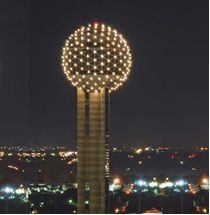 the Dallas
Convention Center. Reunion tower consists of three
floors with circular floor plans on top of four shafts of
poured-in-place
concrete. The top three floors are
encased in an open-air sphere or geodesic dome.
At night the dome at the top of the building lights with hundreds of
bulbs that flash in various computer-generated patterns. Three
rectangular shafts, containing
elevators, rise parallel to the central shaft.
Each shaft's outfacing wall is made up of glass panels, affording views
of the city during the 68-second elevator ride to the top.
the Dallas
Convention Center. Reunion tower consists of three
floors with circular floor plans on top of four shafts of
poured-in-place
concrete. The top three floors are
encased in an open-air sphere or geodesic dome.
At night the dome at the top of the building lights with hundreds of
bulbs that flash in various computer-generated patterns. Three
rectangular shafts, containing
elevators, rise parallel to the central shaft.
Each shaft's outfacing wall is made up of glass panels, affording views
of the city during the 68-second elevator ride to the top.
Reunion Tower closed for major renovations in
2007. In 2009, celebrity chef Wolfgang
Puck opened the fine-dining restaurant, Five Sixty, on the tower's
rotating top level. The name is a
reference to the restaurant's elevation.
The middle floor of the tower is used for special events managed by
Wolfgang Puck Catering. As of July 2011, the observation deck was
still closed off to the
public, but it was said to reopen later in the year. The tower
and hotel are owned by Woodbine
Development Corp. John Scovell is
president and ceo.
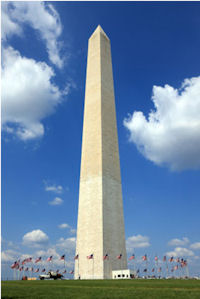 Washington Monument is a
555.5-foot monumental column built to commemorate the first US
president George
Washington. It is the iconic landmark of
Washington DC. It was designed by Robert
Mills, an architect who had just been chosen Architect of Public
Buildings for
Washington in 1836. The tower is made of
marble, granite and stone. Construction
started in 1848 but was not completed until 1884, almost 30 years after
the
architect’s death, due to a lack of funds and the interruption of the
American
Civil War. The completed monument was
dedicated in 1885 and opened in 1888. Upon
completion, it became the world’s tallest structure,
a title
previously held by Cologne Cathedral. The
monument held this designation until 1889, when the
Eiffel Tower was
completed in Paris. The Washington
Monument attracted large crowds before it officially opened. During the six months that followed its
dedication, more than 10,000 people climbed the 897 steps to the top. The original elevator was a steam elevator
that
took 20 minutes to go to the top. As
early as 1888, an average of 55,000 people per month climbed to the
peak. Today, the Washington Monument has
more than
800,000 visitors annually. In August
2011, the tower experienced damaged cause by the Virginia Earthquake. It was closed indefinitely in September 2011
for inspection by rappellers at a cost of $200,000.
It is managed by the National Park
Service.
Washington Monument is a
555.5-foot monumental column built to commemorate the first US
president George
Washington. It is the iconic landmark of
Washington DC. It was designed by Robert
Mills, an architect who had just been chosen Architect of Public
Buildings for
Washington in 1836. The tower is made of
marble, granite and stone. Construction
started in 1848 but was not completed until 1884, almost 30 years after
the
architect’s death, due to a lack of funds and the interruption of the
American
Civil War. The completed monument was
dedicated in 1885 and opened in 1888. Upon
completion, it became the world’s tallest structure,
a title
previously held by Cologne Cathedral. The
monument held this designation until 1889, when the
Eiffel Tower was
completed in Paris. The Washington
Monument attracted large crowds before it officially opened. During the six months that followed its
dedication, more than 10,000 people climbed the 897 steps to the top. The original elevator was a steam elevator
that
took 20 minutes to go to the top. As
early as 1888, an average of 55,000 people per month climbed to the
peak. Today, the Washington Monument has
more than
800,000 visitors annually. In August
2011, the tower experienced damaged cause by the Virginia Earthquake. It was closed indefinitely in September 2011
for inspection by rappellers at a cost of $200,000.
It is managed by the National Park
Service.
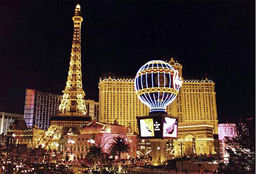 Las Vegas Eiffel Tower
aka Paris Las Vegas opened in 1999 as a hotel and casino.
The Paris Hotel has 2,915 rooms and 85,000 sq
feet of casino space. The front of the
hotel is designed to look like the Paris Opera House and the Louvre. The Las Vegas Eiffel Tower is a half-scale
replica that reaches 541 feet high. The
Eiffel Tower restaurant is located on the 11th floor. You can
take a glass-enclosed elevator to the
top of the observation deck at 460 feet. When
the scale model of the Eiffel Tower was built, it was
planned to be
full-scale, but the airport was too close and the tower had to be
shrunk. The architect was Bergman Walls
Associates. Building began in 1997 under
Hilton Hotels; Hilton’s casinos were sold off to Park Place
Entertainment,
which purchased Caesar’s World in 2000 and changed its name to Caesar’s
Entertainment in 2004. The Paris Hotel
is linked to its sister property, Bally’s, and to the Las Vegas
Monorail.
Las Vegas Eiffel Tower
aka Paris Las Vegas opened in 1999 as a hotel and casino.
The Paris Hotel has 2,915 rooms and 85,000 sq
feet of casino space. The front of the
hotel is designed to look like the Paris Opera House and the Louvre. The Las Vegas Eiffel Tower is a half-scale
replica that reaches 541 feet high. The
Eiffel Tower restaurant is located on the 11th floor. You can
take a glass-enclosed elevator to the
top of the observation deck at 460 feet. When
the scale model of the Eiffel Tower was built, it was
planned to be
full-scale, but the airport was too close and the tower had to be
shrunk. The architect was Bergman Walls
Associates. Building began in 1997 under
Hilton Hotels; Hilton’s casinos were sold off to Park Place
Entertainment,
which purchased Caesar’s World in 2000 and changed its name to Caesar’s
Entertainment in 2004. The Paris Hotel
is linked to its sister property, Bally’s, and to the Las Vegas
Monorail.
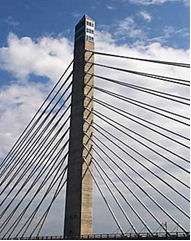 Penobscot Observatory
Tower is part of Penobscot Narrows Bridge near Bucksport, Maine. The bridge uses a cradle system that carries
the strands within the stays from bridge deck to bridge deck, as a
continuous
element, eliminating anchorages in the pylons. The
bridge appeared in the December 2006 issue of Popular
Science as one
of the 100 best innovations of the year. The
total project cost $85 million and took 42
months to complete. The bridge is also
home to the Penobscot Narrow Observatory, the first bridge observation
tower in
the United States and the tallest bridge observatory in the world. It reaches 420 feet into the air and allows
visitors to view the bridge, nearby Fort Knox State Historic Site and
the
Penobscot River and Bay. The tower
opened in 2007. More than 81,300 people
visit each year. Admission prices are $7
for adult non-residents and $5 for adult residents; $3 for children
5-11 and
free for children 4 and under for the observatory and the Fort Knox
site. Both are open May 1 to October
31.81.389
Penobscot Observatory
Tower is part of Penobscot Narrows Bridge near Bucksport, Maine. The bridge uses a cradle system that carries
the strands within the stays from bridge deck to bridge deck, as a
continuous
element, eliminating anchorages in the pylons. The
bridge appeared in the December 2006 issue of Popular
Science as one
of the 100 best innovations of the year. The
total project cost $85 million and took 42
months to complete. The bridge is also
home to the Penobscot Narrow Observatory, the first bridge observation
tower in
the United States and the tallest bridge observatory in the world. It reaches 420 feet into the air and allows
visitors to view the bridge, nearby Fort Knox State Historic Site and
the
Penobscot River and Bay. The tower
opened in 2007. More than 81,300 people
visit each year. Admission prices are $7
for adult non-residents and $5 for adult residents; $3 for children
5-11 and
free for children 4 and under for the observatory and the Fort Knox
site. Both are open May 1 to October
31.81.389
Gatlinburg Space
Needle is a 407-foot tall observation tower and tourist attraction
in
Gatlinburg, Tennessee. Opened in 1970,
it took one year to construct. The tower
has an outdoor observation deck that provides a 360-degree view of the
Great
Smoky Mountains and the City of Gatlinburg. Visitors
can take two elevators to the top. The
deck can accommodate 250 people. The
property also has a family fun
center
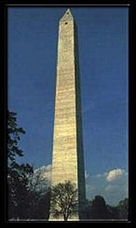 Jefferson Davis
Monument is a tower located within a state park that preserves the
birthplace of Jefferson Davis, the president of the Confederate States
of
America. The site is in Fairview,
Kentucky --- about 9 miles east of Hopkinsville. The
focus point of the site is a 351-foot
tall unreinforced concrete tower. No
steel was used to reinforce the concrete. As
one pour was completed, large chucks of limestone were
left
projecting up to connect it to the next pour above.
Architects are Major SF Crecelius and GR
Gregg. Construction began in 1917 but
stopped in 1918 due to building material rationing during World War I. Construction resumed in 1922 and was finished
in 1924 at a cost of $200,000. The tower
was closed to public from 1999 until 2004 for renovations and
construction of a
new visitor center. An elevator takes
visitors to an observation platform at the top of the tower. It is the third-tallest obelisk behind the
San Jacinto Monument and the Washington Monument. Annual
visitor attendance is 15,000 to
20,000.
Jefferson Davis
Monument is a tower located within a state park that preserves the
birthplace of Jefferson Davis, the president of the Confederate States
of
America. The site is in Fairview,
Kentucky --- about 9 miles east of Hopkinsville. The
focus point of the site is a 351-foot
tall unreinforced concrete tower. No
steel was used to reinforce the concrete. As
one pour was completed, large chucks of limestone were
left
projecting up to connect it to the next pour above.
Architects are Major SF Crecelius and GR
Gregg. Construction began in 1917 but
stopped in 1918 due to building material rationing during World War I. Construction resumed in 1922 and was finished
in 1924 at a cost of $200,000. The tower
was closed to public from 1999 until 2004 for renovations and
construction of a
new visitor center. An elevator takes
visitors to an observation platform at the top of the tower. It is the third-tallest obelisk behind the
San Jacinto Monument and the Washington Monument. Annual
visitor attendance is 15,000 to
20,000.
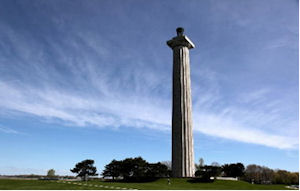 Perry’s Victory &
International Peace Memorial commemorates the Battle of Lake
Erie in which
Commodore Oliver Perry led a fleet to victory in one of the most
significant
naval battles of the War of 1812.
Located in Put-in-Bay, Ohio, the 352-foot monument is the world’s
massive Doric column. Constructed period
was 1912 to 1915. Funding problems
prevented the fully realized memorial.
In 1919 the federal government assumed control and provided additional
funding. Official dedication was in
1931. The memorial also celebrates the
lasting peace between Britain, Canada and the United States following
the
war. Typically, the tower is visited by 155,000
to 200,000 people each year. However, it
closed in 2009 for 2-3 years of repairs to the observation deck, the
column,
the entrance and the rotunda. The
visitor center is open but the monument won’t reopen until 2012.
The repairs to the observation deck are
estimated at $7 million.
Perry’s Victory &
International Peace Memorial commemorates the Battle of Lake
Erie in which
Commodore Oliver Perry led a fleet to victory in one of the most
significant
naval battles of the War of 1812.
Located in Put-in-Bay, Ohio, the 352-foot monument is the world’s
massive Doric column. Constructed period
was 1912 to 1915. Funding problems
prevented the fully realized memorial.
In 1919 the federal government assumed control and provided additional
funding. Official dedication was in
1931. The memorial also celebrates the
lasting peace between Britain, Canada and the United States following
the
war. Typically, the tower is visited by 155,000
to 200,000 people each year. However, it
closed in 2009 for 2-3 years of repairs to the observation deck, the
column,
the entrance and the rotunda. The
visitor center is open but the monument won’t reopen until 2012.
The repairs to the observation deck are
estimated at $7 million.
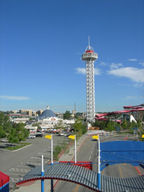 ElitchGardens Observation Tower in Denver, Colorado is a 330-foot tower
that sits at the entrance of the newly-relocated Elitch Gardens theme
park that
opened in 1995. Cost of the new
67-acre plot was $6.1 million; relocating rides and building new park
was $90
million and the premier additions for the third season was $28 million
--- a
total of $124.1 million. The
tower’s observation platform at 275-feet
was one of seven new attractions to debut at the new park.
In 2001, the
elevator in the observation tower became stuck and trapped 12 people
for more
than an hour. All 12 people made it
safely out when firefighters drilled a hole in the elevator car to
allow the
passengers to walk down the tower stairs. The
tower was often closed or subject to inclement
weather. The tower was built by HUSS Park
Attractions
of Bremen, Germany. CNL Lifestyle
Properties bought Elitch Gardens in 2007 with a lease back to PARC who
defaulted on the lease in 2010. Herschend
Family Entertainment took over day to day
management in
January 2011.
ElitchGardens Observation Tower in Denver, Colorado is a 330-foot tower
that sits at the entrance of the newly-relocated Elitch Gardens theme
park that
opened in 1995. Cost of the new
67-acre plot was $6.1 million; relocating rides and building new park
was $90
million and the premier additions for the third season was $28 million
--- a
total of $124.1 million. The
tower’s observation platform at 275-feet
was one of seven new attractions to debut at the new park.
In 2001, the
elevator in the observation tower became stuck and trapped 12 people
for more
than an hour. All 12 people made it
safely out when firefighters drilled a hole in the elevator car to
allow the
passengers to walk down the tower stairs. The
tower was often closed or subject to inclement
weather. The tower was built by HUSS Park
Attractions
of Bremen, Germany. CNL Lifestyle
Properties bought Elitch Gardens in 2007 with a lease back to PARC who
defaulted on the lease in 2010. Herschend
Family Entertainment took over day to day
management in
January 2011.
The Statue of
Liberty
in New York Harbor is a neo-classical sculpture of a robed female
figure
representing Libertas, the Roman goddess of freedom, who bears a torch
and a
tablet of laws. Designed by Frederic
Auguste Bartholde, the Statue of Liberty was a gift to the United
States from
the people of France. The French were to
finance the statue and the Americans were to provide the site and the
pedestal.  Bartholde completed the head
and torch-bearing arm before the statue was fully designed, and these
pieces
were exhibited at international expositions. Fundraising
for the pedestal proved difficult until
publisher Joseph
Pulitzer started a campaign to raise $100,000 ($2.3 million today) by
promising
to publish the name of every contributor no matter how small the amount
given. Donations flooded in.
The statue was constructed in France, shipped
overseas in crates and assembled on its pedestal on Bedloe Island, now
Liberty
Island, in 1886. Ships arriving in New
York City had to sail past it. The
statue rapidly became a landmark. Many
immigrants who entered through New York saw it as a welcoming sign.
Bartholde completed the head
and torch-bearing arm before the statue was fully designed, and these
pieces
were exhibited at international expositions. Fundraising
for the pedestal proved difficult until
publisher Joseph
Pulitzer started a campaign to raise $100,000 ($2.3 million today) by
promising
to publish the name of every contributor no matter how small the amount
given. Donations flooded in.
The statue was constructed in France, shipped
overseas in crates and assembled on its pedestal on Bedloe Island, now
Liberty
Island, in 1886. Ships arriving in New
York City had to sail past it. The
statue rapidly became a landmark. Many
immigrants who entered through New York saw it as a welcoming sign.
Visitors could climb up the arm into the
observation platform
that surrounds the torch. Not very tall,
the lady measures only 305 feet from the ground to the tip of her
torch, but
she is one powerful icon representing not only a city but a whole
nation. And she speaks, “Give me your
tired, your
poor, your huddled masses yearning to breathe free.”
If there is one visual symbol for Brand USA,
this is it!
Typically, about 3.2 million people visit the icon every
year. Over the years, an elevator and
exterior lighting were added. Major
renovations were made in 1976 and 1984-1986. After
the 9-11 attacks, the statue and Liberty Island were
immediately
closed to the public. The island
reopened at the end of 2001, while the pedestal and statue remained
closed. The pedestal reopened in 2004
but the National Park Service announced that people could not safely
enter the
statue due to a difficult evacuation in an emergency.
On July 4, 2009, the statue reopened to a
limited number of people that could ascend to the crown each day. On October 29, 2011, the statue, pedestal and
base closed for up to a year to install new elevators and stairs and to
upgrade
security and other facilities at a cost of $27.4 million, but Liberty
Island
remains open.
 The Sunsphere in Knoxville,
Tennessee is a 266-foot high hexagon steel truss tower topped with a
75-foot
gold-colored glass sphere that serves as a symbol of the 1982 World’s
Fair. Designed by the local firm of
Community Tectonics, the 86.5-foot sphere corresponds to the 865,000
mile
diameter of the sun. Most of the World’s
Fair site is now a public park and a convention center, but the 7-story
Sunsphere remains. During the fair, it
cost $2 to take the elevator to the observation deck and restaurant.
The Sunsphere in Knoxville,
Tennessee is a 266-foot high hexagon steel truss tower topped with a
75-foot
gold-colored glass sphere that serves as a symbol of the 1982 World’s
Fair. Designed by the local firm of
Community Tectonics, the 86.5-foot sphere corresponds to the 865,000
mile
diameter of the sun. Most of the World’s
Fair site is now a public park and a convention center, but the 7-story
Sunsphere remains. During the fair, it
cost $2 to take the elevator to the observation deck and restaurant.
While the Sunsphere is the most recognized feature of the
Knoxville cityscape, it has remained vacant and underutilized for most
of its
life. Various proposals have been
submitted and failed. Unfortunately, the
tall structure was built one of the lowest parts of the city. The adjacent Convention Center opened in
2001. The observation deck, which holds
86 people, reopened in 2007 to give visitors a view of Knoxville. Food and beverage facilities were tried, but
now business offices occupy most of the space.
Liberty Memorial in
Kansas City, Missouri is a 216-foot observation tower that is part
of a
memorial and museum dedicated to the fallen soldiers of World War I. The memorial opened in 1926.
It was designed by Harold Van Buren Magonigle
and built by Westlake Construction Company. The
National World War I Museum opened in 2006. Admission
to the museum and observation deck
is $5 for adults. Management is provided
by a local non-profit organization in cooperation with Kansas City
Parks &
Recreation.
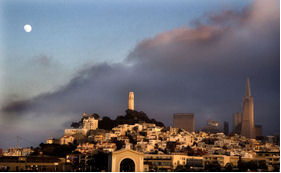 Coit Tower is a
210-foot tower built on Telegraph Hill in San Francisco, California. The white fluted concrete tower was designed
by architects Arthur Brown Jr and Henry Howard. It
took 5 years to build and opened in 1933. The
tower is named for Lillie Hitchcock Coit,
a wealthy eccentric and patron of the city’s volunteer firefighters. For a $5 adult fee, you can ride the elevator
to the observation deck for majestic views of the city and bay. However, one does not have to climb to the
top of the tower to get a great view. Telegraph
Hill itself is 300-feet high, and the view from
the parking
area at the base of Coit Tower is excellent. While
the main attraction of Coit Tower is the view, the
murals are
worth seeing. The walls inside the
rotunda are decorated with murals inspired by the murals of Diego
Rivera, which
depict life in California during the Depression. The
murals are open for public viewing
without charge during open hours.
Coit Tower is a
210-foot tower built on Telegraph Hill in San Francisco, California. The white fluted concrete tower was designed
by architects Arthur Brown Jr and Henry Howard. It
took 5 years to build and opened in 1933. The
tower is named for Lillie Hitchcock Coit,
a wealthy eccentric and patron of the city’s volunteer firefighters. For a $5 adult fee, you can ride the elevator
to the observation deck for majestic views of the city and bay. However, one does not have to climb to the
top of the tower to get a great view. Telegraph
Hill itself is 300-feet high, and the view from
the parking
area at the base of Coit Tower is excellent. While
the main attraction of Coit Tower is the view, the
murals are
worth seeing. The walls inside the
rotunda are decorated with murals inspired by the murals of Diego
Rivera, which
depict life in California during the Depression. The
murals are open for public viewing
without charge during open hours.
Under
Construction / In Development
Two observation towers are under construction or in the
planning phase:
Port Canaveral wants
to start attracting tourists and cruise passengers.
The Port Authority unveiled plans in 2010 to
build a new maritime museum, visitor center and 300-foot observation
tower that
could cost $30 million. Conceptual
designers say the tower might look a bit like a sail and be high enough
so
visitors could see over the cruise ships and get a full view of the
Space Coast,
according to Port Authority CEO Stan Payne. The
Port Commission approved spending $380,000 on a set of
feasibility
studies with the 1513 Foundation, a group working on a 500th
anniversary of Ponce de Leon’s landing on the Florida coast. AECOM is consulting on the project. In September 2010, the Port Authority began a
shorter-term destination project for completion in 2011 --- an open-air
Cove
Marketplace which will expand to include a visitor center, interactive
exhibits,
4-D theater and a free standing observation tower.
The 1513 Foundation has taken responsibility
for raising the funds to open these facilities by 2013 for the Explore
Florida
500 celebration.
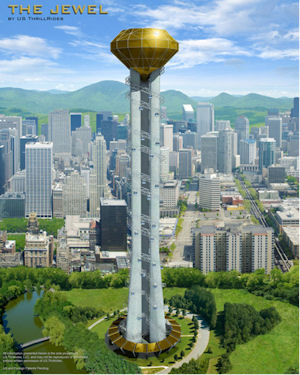 SkySpire is the brainchild
of
attractions inventor Bill Kitchen. It is
both an Observation Tower and Thrill Ride.
The tower ride provides a continuous (walk-on/walk-off, loading and
unloading) flow of passengers both at the ground and
observatory levels. For example, people
can enter a glass-enclosed elevator and ride to the top through the
center of
the tower, then exit to enjoy the observation deck’s 360-degree
panoramic views. When ready to leave, the
riders enter a
gondola that spirals down around the outside of the tower back to earth. Capacity can be controlled by the height of
the tower, the speed of elevator, the observation time and the speed of
the
descent. The towers can be constructed
from 250 feet to 3,000 feet in height. The
up ride can vary from 10 to 30 minutes and can deliver
1,000 to
3,000 people per hour. It is unique,
affordable and requires a very small footprint. SkySpire
comes in two sizes: in-park and megatower from US
Thrill Rides,
which is currently installing a SkyQuest suspended beam ride at the
Indianapolis Zoo and a SkyView observation wheel with Merlin
Entertainment on
International Drive in Orlando. The
first SkySpire is a closely guarded secret. For
more, go to www.usthrillrides.com.
SkySpire is the brainchild
of
attractions inventor Bill Kitchen. It is
both an Observation Tower and Thrill Ride.
The tower ride provides a continuous (walk-on/walk-off, loading and
unloading) flow of passengers both at the ground and
observatory levels. For example, people
can enter a glass-enclosed elevator and ride to the top through the
center of
the tower, then exit to enjoy the observation deck’s 360-degree
panoramic views. When ready to leave, the
riders enter a
gondola that spirals down around the outside of the tower back to earth. Capacity can be controlled by the height of
the tower, the speed of elevator, the observation time and the speed of
the
descent. The towers can be constructed
from 250 feet to 3,000 feet in height. The
up ride can vary from 10 to 30 minutes and can deliver
1,000 to
3,000 people per hour. It is unique,
affordable and requires a very small footprint. SkySpire
comes in two sizes: in-park and megatower from US
Thrill Rides,
which is currently installing a SkyQuest suspended beam ride at the
Indianapolis Zoo and a SkyView observation wheel with Merlin
Entertainment on
International Drive in Orlando. The
first SkySpire is a closely guarded secret. For
more, go to www.usthrillrides.com.
And finally --- to sum it up:
Cities compete on an international stage to attract
visitors. City icons, such as
observation towers, play an important role in communicating a story
about fun
times to be had. The hardest thing for
city leaders is deciding what idea or value they want to express to the
world. For Las Vegas it was easy. Their moniker is Sin City.
Their motto is “What happens in Vegas stays
in Vegas!” For other cities, it’s not so
easy. New York, Chicago, Las Vegas and
Washington DC are among the most famous cities in the USA because they
have
architectural icons, nicknames, slogans and songs that attract even
more
attention such as films and TV shows. But
there are other underrated --- albeit smaller ---
cities in this
country that don’t get their fair share of the spotlight.
Some cities need an extreme makeover.
Others cities are doing makeovers but they
are still undiscovered by the traveling public.
What’s your city’s claim to fame?
Click here to access City
Branding, Part 1, Nicknames, Slogans & Songs
Click her to access City
Branding: Part 2: Observation Towers Worldwide, Architectural Icons
Make Cities Famous
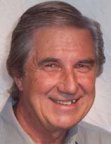
Jeff Coy, ISHC, is president
of JLC Hospitality Consulting based in Phoenix-Cave Creek AZ. He
is certified by the International Society
of Hospitality Consultants. For more
about market research, economic feasibility and design-development
services for
all kinds of resorts, waterparks, adventure parks, observation towers,
tourist attractions
and sports facilities, call 480-488-3382
or email jeffcoy@jeffcoy.com or go to www.jeffcoy.com.

 Just say the word Orlando and visual images of Mickey
Mouse, the
Magic Kingdom, Shamu and thrill rides appear in my mind’s eye.
Just say the word Orlando and visual images of Mickey
Mouse, the
Magic Kingdom, Shamu and thrill rides appear in my mind’s eye.
 Casino, Hotel &
Tower.
Casino, Hotel &
Tower. Royal Gorge Bridge &
Park is a tourist attraction near Canon City CO within a 360-acre
theme park.
Royal Gorge Bridge &
Park is a tourist attraction near Canon City CO within a 360-acre
theme park. North America.
North America. tallest observation tower in the USA from 1968-1996,
when the Las Vegas Stratosphere Tower was completed.
tallest observation tower in the USA from 1968-1996,
when the Las Vegas Stratosphere Tower was completed.

 The Space Needle features an
observation deck at 520 feet
and the rotating SkyCity Restaurant at 500 feet.
The Space Needle features an
observation deck at 520 feet
and the rotating SkyCity Restaurant at 500 feet. Kennedy Space Center
Launch Complex 39 is a NASA rocket launch site on Merritt Island in
Florida
that consists of two launch pad towers, a Vehicle Assembly Building
crawler-transporter, launch control center and other support buildings
used in
the Apollo, Saturn programs and later Space Shuttle operations.
Kennedy Space Center
Launch Complex 39 is a NASA rocket launch site on Merritt Island in
Florida
that consists of two launch pad towers, a Vehicle Assembly Building
crawler-transporter, launch control center and other support buildings
used in
the Apollo, Saturn programs and later Space Shuttle operations. Plaza (formerly the Omni
Netherland Plaza). The
hotel is described as "one of the world's finest examples of French Art
Deco architecture" and was used as the model for the Empire State
Building in New York City. Carew Tower
is technically a building, not a tower, because it has floors from the
group up. Prior to the Great American Insurance
Building, Carew Tower gave Cincinnati the distinction of having an
American
city's tallest building, constructed pre-World War II. The
building originally had three towers, the
tallest housing offices, the second the hotel, and the third
serving as a parking garage which had an elevator rather than
traditional ramps for access. There
was also a turntable for vehicles to assist in pointing delivery trucks
in the
right direction. The system has since
been dismantled. From 1967 to 1980, the
Carew Tower was featured in the opening and closing credits of the
long-running
daytime soap opera
Plaza (formerly the Omni
Netherland Plaza). The
hotel is described as "one of the world's finest examples of French Art
Deco architecture" and was used as the model for the Empire State
Building in New York City. Carew Tower
is technically a building, not a tower, because it has floors from the
group up. Prior to the Great American Insurance
Building, Carew Tower gave Cincinnati the distinction of having an
American
city's tallest building, constructed pre-World War II. The
building originally had three towers, the
tallest housing offices, the second the hotel, and the third
serving as a parking garage which had an elevator rather than
traditional ramps for access. There
was also a turntable for vehicles to assist in pointing delivery trucks
in the
right direction. The system has since
been dismantled. From 1967 to 1980, the
Carew Tower was featured in the opening and closing credits of the
long-running
daytime soap opera  Land was purchased in 1897 for the site.
Land was purchased in 1897 for the site. the Dallas
Convention Center. Reunion tower consists of three
floors with circular floor plans on top of four shafts of
poured-in-place
concrete. The top three floors are
encased in an open-air sphere or geodesic dome.
At night the dome at the top of the building lights with hundreds of
bulbs that flash in various computer-generated patterns. Three
rectangular shafts, containing
elevators, rise parallel to the central shaft.
Each shaft's outfacing wall is made up of glass panels, affording views
of the city during the 68-second elevator ride to the top.
the Dallas
Convention Center. Reunion tower consists of three
floors with circular floor plans on top of four shafts of
poured-in-place
concrete. The top three floors are
encased in an open-air sphere or geodesic dome.
At night the dome at the top of the building lights with hundreds of
bulbs that flash in various computer-generated patterns. Three
rectangular shafts, containing
elevators, rise parallel to the central shaft.
Each shaft's outfacing wall is made up of glass panels, affording views
of the city during the 68-second elevator ride to the top.  Washington Monument is a
555.5-foot monumental column built to commemorate the first US
president George
Washington.
Washington Monument is a
555.5-foot monumental column built to commemorate the first US
president George
Washington. Las Vegas Eiffel Tower
aka Paris Las Vegas opened in 1999 as a hotel and casino.
Las Vegas Eiffel Tower
aka Paris Las Vegas opened in 1999 as a hotel and casino. Penobscot Observatory
Tower is part of Penobscot Narrows Bridge near Bucksport, Maine.
Penobscot Observatory
Tower is part of Penobscot Narrows Bridge near Bucksport, Maine. Jefferson Davis
Monument is a tower located within a state park that preserves the
birthplace of Jefferson Davis, the president of the Confederate States
of
America.
Jefferson Davis
Monument is a tower located within a state park that preserves the
birthplace of Jefferson Davis, the president of the Confederate States
of
America. Perry’s Victory &
International Peace Memorial
Perry’s Victory &
International Peace Memorial ElitchGardens Observation Tower
ElitchGardens Observation Tower Bartholde completed the head
and torch-bearing arm before the statue was fully designed, and these
pieces
were exhibited at international expositions.
Bartholde completed the head
and torch-bearing arm before the statue was fully designed, and these
pieces
were exhibited at international expositions. The Sunsphere in Knoxville,
Tennessee is a 266-foot high hexagon steel truss tower topped with a
75-foot
gold-colored glass sphere that serves as a symbol of the 1982 World’s
Fair.
The Sunsphere in Knoxville,
Tennessee is a 266-foot high hexagon steel truss tower topped with a
75-foot
gold-colored glass sphere that serves as a symbol of the 1982 World’s
Fair. Coit Tower is a
210-foot tower built on Telegraph Hill in San Francisco, California.
Coit Tower is a
210-foot tower built on Telegraph Hill in San Francisco, California. SkySpire
SkySpire
